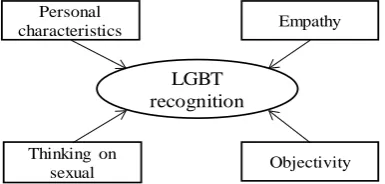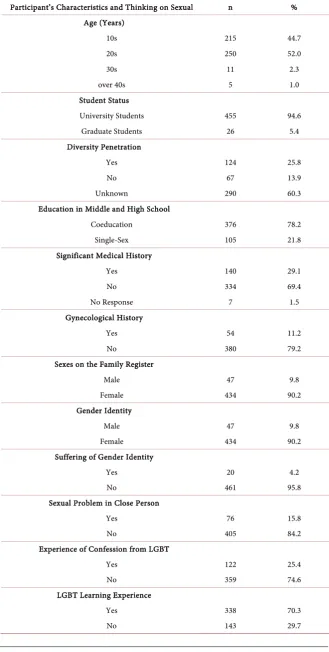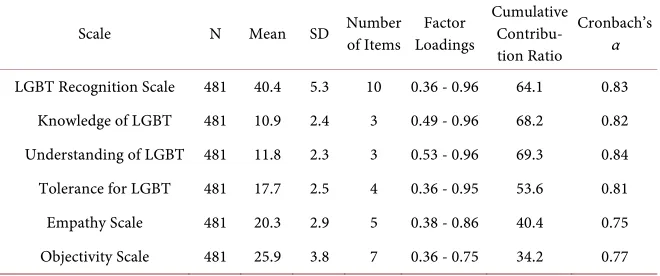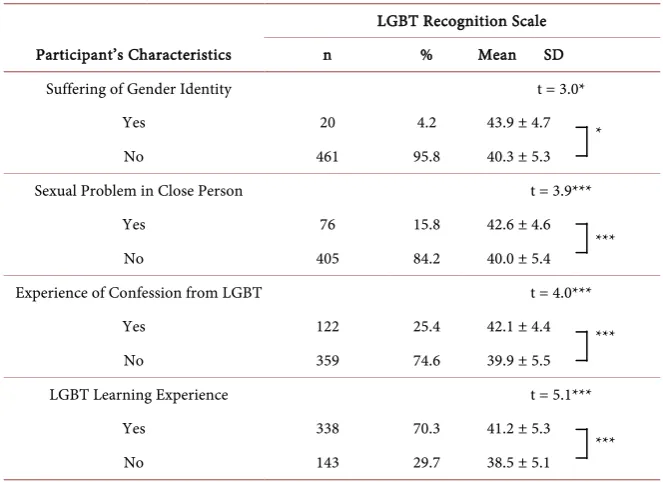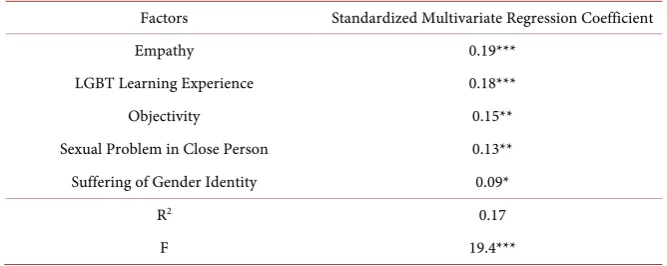http://www.scirp.org/journal/ojn ISSN Online: 2162-5344
ISSN Print: 2162-5336
DOI: 10.4236/ojn.2019.95041 May 16, 2019 481 Open Journal of Nursing
Predictors of LGBT Recognition by Health
Sciences University Students in Japan
Kyoko Asazawa , Ai Inamoto, Misaki Suzuki, Yukari Ashino, Yurina Ishihara, Yumu Oba, Maki Endo, Ayumi Iwata, Miki Kishioka, Arisa Tokunaga, Miharu Sumino, Natsuko Kojima, Eriko Shinohara
Division of Nursing, Faculty of Nursing, Tokyo Healthcare University, Tokyo, Japan
Abstract
Background: This study aimed to identify the predictors of LGBT recogni-tion by health sciences university students in Japan. Methods: This is a cross-sectional study that used quantitative data collected from 481 returned self-report questionnaires distributed to 866 health sciences undergraduate and graduate students. The following survey item and scales were used for measuring the main outcomes: Thoughts about sexual identity, Empathy scale, Objectivity scale, and LGBT recognition scale. Data were analyzed us-ing descriptive statistics, two-sample t-test, one-way analysis of variance, and multiple regression analyses. SPSS ver. 23.0 (SPSS, Chicago, IL, USA) was used for data analysis at a 5% significance level. Results: The number of returned questionnaires was 481 (55.5%). There was no significant dif-ference in the LGBT recognition and the participant’s characteristics (e.g., age and medical history). The 5 significant predictors of LGBT recognition were: 1) Empathy (β = 0.19, p < 0.001); 2) LGBT learning experience (β = 0.18, p < 0.001); 3) Objectivity (β = 0.15, p < 0.01); 4) Sexual problem with a close person (β = 0.13, p < 0.01); and 5) Suffering from gender identity (β = 0.09, p < 0.05). Conclusions: The predictive factors of LGBT recognition were Empathy, LGBT learning experience, Objectivity, Sexual problem with a close person, and Suffering from gender identity. Careful development and implementation of LGBT educational programs are needed to better un-derstand the situations and ideas of LGBT parties to enhance their recogni-tion.
Keywords
Sexual and Gender Minorities, Recognition, Students, Health Occupations, Cross-Sectional Studies
How to cite this paper: Asazawa, K., In-amoto, A., Suzuki, M., Ashino, Y., Ishihara, Y., Oba, Y., Endo, M., Iwata, A., Kishioka, M., Tokunaga, A., Sumino, M., Kojima, N. and Shinohara, E. (2019) Predictors of LGBT Recognition by Health Sciences University Students in Japan. Open Journal of Nursing, 9, 481-493.
https://doi.org/10.4236/ojn.2019.95041
Received: March 6, 2019 Accepted: May 13, 2019 Published: May 16, 2019
Copyright © 2019 by author(s) and Scientific Research Publishing Inc. This work is licensed under the Creative Commons Attribution International License (CC BY 4.0).
DOI: 10.4236/ojn.2019.95041 482 Open Journal of Nursing
1. Introduction
A survey conducted on general adults in Japan showed that the percentage of sexual minorities such as lesbian, gay, bisexual and transgender (LGBT) is only about 5.9% [1]. Bisexual orientation and transgender identity are usually hidden and are unlikely to be recognized unless openly confessed [2]. Recently in Japan, many LGBT parties and other organizations conduct various activities such as the Tokyo Rainbow Parade to overcome being unrecognized [1].
In 2015, the Shibuya ward in Tokyo established a regulation, issued partner-ship certificates, and introduced a system that makes same-sex couples equiva-lent to legal couples [1]. In the same year, the Japanese Ministry of Education, Culture, Sports, Science and Technology launched a program called “Imple-mentation of Fine-grained Response to Children with Gender Identity Disord-er”. The contents of the program included important response aspects for not only gender identity disorder but also homosexuals and bisexuals (LGBs) [1] [3].
With the development of such social phenomena, information on LGBT has been rapidly taken up in mass media. Among welfare students in Japan, the most frequent source of information on homosexuality was the television, followed by magazines and friends [4]. Most Japanese students obtain their information on LGBT from the television, although such information may possibly be biased. The mass media has unfortunately connoted the word “LGBT” with “not related to us” or “unfamiliar people” under the present circumstances [5]. Moreover, the sexual orientation of LGBs and the sexual identity disorder of transgenders (T) are not commonly distinguished in Japan [5]. Among the elementary and junior high school teachers involved in the education of children with gender identity disorders, the percentage of faculty who can clearly explain the differ-ence between LGB and T is low at 31.6% [6]. Under such circumstances, it is considered difficult to educate students and increase their awareness of LGBT.
On the other hand, various LGBT parties in Japan are prone to develop self-hatred and loneliness because of the discriminative remarks and actions against LGBTs by people with a low recognition, making them suicidal high-risk groups because of their poor self-esteem [7] [8]. Furthermore, LGBT parties in Japan encounter various problems in their daily life. These include not having their own dedicated restrooms [9], limitations on the time to visit their same-sex partner during hospitalization and end-of-life stay [1], cannot become com-pletely dependent of health insurance [1], and not being able to sign a consent form for emergency operation [10].
DOI: 10.4236/ojn.2019.95041 483 Open Journal of Nursing knowledge of and attitudes to LGBTs have been achieved by nursing students through educational programs about their nursing care [11]. Indeed, what is common between Japan and other countries is that LGBT parties experience real and various difficulties in life.
Medical professionals including nurses involved in healthcare need to recog-nize and understand various gender identities and respond appropriately to LGBT patients. In Japan, the fundamental problem is the lack of previous studies on LGBT recognition by healthcare professionals and medical healthcare stu-dents.
In this study, we evaluated Japanese medical healthcare students and clarified their current knowledge of LGBT recognition. Specifically, we aimed to identify the relevant factors for LGBT recognition by medical healthcare students.
2. Methods
2.1. Study Design
This study was a descriptive quantitative cross-sectional questionnaire survey.
2.2. Definition of Terms
LGBT: Lesbian, Gay, Bisexual, Transgender is a generic term for transgender, which represents sexual and gender minorities;
Lesbian: Homosexuality of women in which the physical gender and love subjects are women;
Gay: Homosexuality in men in which the physical gender and love subjects are men;
Bisexual: Encompasses cases where men or women may be the subject of romance;
Transgender: A person with sexual identity disorder or gender disagreement that does not conform to physical gender and psychological gender.
2.3. Conceptual Framework
[image:3.595.278.471.613.705.2]We developed a conceptual framework according to the background of the medical healthcare students related to LGBT recognition. This conceptual framework encompasses different concepts and their relationships to LGBT recognition as follows: Personal characteristics, Thoughts about sexual identity, Empathy, and Objectivity (Figure 1).
Figure 1. Conceptual framework of the study. Personal
characteristics Empathy
LGBT recognition
Thinking on
DOI: 10.4236/ojn.2019.95041 484 Open Journal of Nursing 2.4. Participants and Setting
The participants were Japanese universities undergraduate and graduate stu-dents studying different fields of medical healthcare such as nursing, midwifery, nutrition, and medical information science. Data were collected by purposive sampling of the participants from a convenience sample of university students in the Kanto district of Japan in which the department head of the university agreed to cooperate with this study. The inclusion criteria were: 1) Undergraduate and graduate students studying medical healthcare, and 2) Could communicate in Japanese. The exclusion criterion was students with severe psychiatric disorders.
For multiple regression analysis, the sample size should be 10 times the num-ber of parameters [14]. The sample size required for the present survey was cal-culated using the specification 10 times the number of parameters and a recov-ery rate of 40% [15]. Therefore, the target sample size was set at 875 participants (35 parameters × 10/0.4 = 875).
2.5. Procedures
After obtaining permission from the department head of the university, verbal and written information regarding the research project was provided to the par-ticipants. Submission of the completed questionnaire was considered as indicat-ing consent. Each participant was asked to return the completed questionnaire in a sealed envelope either by post or by placing it in a collection box at the en-trance lobby of the university. During the study period from June 2018 to July 2018, 866 questionnaires were distributed to eligible participants. A total of 520 (60.6%) completed questionnaires were returned, of which 481 (55.5%) were suitable for analyses.
2.6. Ethical Considerations
The study was conducted after obtaining approval from the Ethics Committee for Epidemiological Studies at Tokyo Healthcare University (approval no. 30-6) dated 1 June, 2018. Following the Declaration of Helsinki, a written explanation regarding the study objectives, methods, protection of anonymity, and voluntary basis of participation was provided to each participant. The participants were also informed that the collected data would only be used for this study.
2.7. Survey Contents
2.7.1. Participants’ Attributes
The attributes of the participants surveyed included Age, Student status, Diver-sity experience, Education in middle and high school, Significant medical histo-ry, and Gynecological history (Table 1).
2.7.2. Thoughts about Sexual Identity
DOI: 10.4236/ojn.2019.95041 485 Open Journal of Nursing Table 1. Demographic data of the participants (N = 481).
Participant’s Characteristics and Thinking on Sexual n % Age (Years)
10s 215 44.7 20s 250 52.0 30s 11 2.3 over 40s 5 1.0 Student Status
University Students 455 94.6 Graduate Students 26 5.4 Diversity Penetration
Yes 124 25.8 No 67 13.9 Unknown 290 60.3 Education in Middle and High School
Coeducation 376 78.2 Single-Sex 105 21.8 Significant Medical History
Yes 140 29.1 No 334 69.4 No Response 7 1.5 Gynecological History
Yes 54 11.2 No 380 79.2 Sexes on the Family Register
Male 47 9.8 Female 434 90.2 Gender Identity
Male 47 9.8 Female 434 90.2 Suffering of Gender Identity
Yes 20 4.2 No 461 95.8 Sexual Problem in Close Person
Yes 76 15.8 No 405 84.2 Experience of Confession from LGBT
Yes 122 25.4 No 359 74.6 LGBT Learning Experience
DOI: 10.4236/ojn.2019.95041 486 Open Journal of Nursing problem with a close person, Experience of confession as an LGBT, and LGBT learning experience (Table 1).
2.7.3. LGBT Recognition Scale (10 Items)
The survey items for measuring LGBT recognition were independently devel-oped by the researchers based on previous studies on understanding and con-sciousness of LGBT [4] [5] [7] [9]. The 3 sub-scales of the LGBT recognition scale consisted of the Knowledge of LGBT, Understanding of LGBT, and Toler-ance for LGBT. The original version of the LGBT recognition scale has a total of 10 items which are scored as follows: “Strongly Disagree” 1 point, “Disagree” 2 points, “Neutral” 3 points, “Agree” 4 points, and “Strongly Agree” 5 points. The score ranges from 10 to 50 points. The higher the score is, the higher the LGBT recognition. The reliability and validity of the LGBT recognition scale have been verified in this study. This scale was used to measure the level of LGBT recogni-tion by the medical healthcare students.
2.7.4. Empathy Scale
For empathy measurements, empathy, a subscale of the multidimensional em-pathy scale, was used [16]. This scale has 5 items that are related to empathy to others, asking responses to each item, and then calculating the score. This scale measures the reaction tendency of cognitive and emotional responses to the psychological state of others in accordance with a multidimensional approach of empathy. The score ranges from 5 to 25 points. The higher the score is, the higher the empathy to others. The reliability and validity of the empathy scale have been confirmed by the developers, and the Cronbach’s α was 0.71 [16]. Factor analysis was conducted in this survey, and the scale score was calculated after reconfirming the reliability. In the present study, empathy was added to the survey items as it was expected to be related to LGBT recognition. Also, empathy was used to confirm the validity of the coexistence of the LGBT recognition scale.
2.7.5. Objectivity Scale
For the measurement of objectivity, we used an objectivity subscale of the Criti-cal Thinking Attitude SCriti-cale [17]. This objectivity scale has 7 items related to ob-jectivity, and 5 points are required for the answers to each item. The scores are then calculated and ranges from 7 to 35 points. A higher score indicates a more objective judgment and a more positive attitude about the position of others. The reliability and validity of this objectivity scale have been confirmed, and Cronbach’s α = 0.73 has been reported [17]. In this survey, factor analysis was conducted and the scale score was calculated after reconfirming the reliability. Objectivity was predicted to be related to LGBT recognition, thus it was incor-porated into the survey items. Also, objectivity was used to confirm the validity of the coexistence of the LGBT recognition scale.
2.8. Statistical Analysis
signific-DOI: 10.4236/ojn.2019.95041 487 Open Journal of Nursing ance level was set at 5%. The alpha coefficient and factor loadings were calcu-lated to examine the reliability of the responses on each scale. The two-sample t-test, one-way analysis of variance (ANOVA), and stepwise multiple regression analysis were also used for data analyses. For the first step in the data analysis, the correlations between LGBT recognition and participants’ characteristics were examined using the two-sample t-test and one-way ANOVA. For the second step, 10 variables were entered as independent variables to determine which variables affected LGBT recognition as dependent variables using stepwise multiple regression analysis.
3. Results
During the study period, 866 questionnaires were distributed to eligible partici-pants. A total of 520 completed questionnaires (60.6%) were returned, of which 481 were suitable for analyses. Therefore, the response rate was 55.5%.
3.1. Participants’ Characteristics
The characteristics of the participants are summarized in Table 1. There were 215 (44.7%) participants who were in their 10s and 250 (52.0%) participants who were in their 20s. There were 455 undergraduate students (94.6%) and 26 gradu-ate students (5.4%). The family register indicgradu-ated 47 men (9.8%) and 434 women (90.2%). There were 20 students (4.2%) who suffered from gender identity, and 76 students (15.8%) had Sexual problem with a close person. There were 122 students (25.4%) who had the Experience of confession as an LGBT, and 338 students (70.3%) had LGBT learning experience.
3.2. Reliability and Validity of the Scales
The factor structure was confirmed for each variable in the following 3 meas-ures: LGBT recognition, Empathy, and Objectivity. The construct validity was confirmed by factor analysis using the maximum likelihood method and promax rotation. The results of the factor analysis yielded a factor loading of 0.36 or more for all the items, and the cumulative contribution rate was 34.2% or more for all the scales. The contribution rate of LGBT recognition scale was 64.1%. The reliability of the scales was confirmed using the Cronbach’s α coefficient, which ranged from 0.75 to 0.84.
DOI: 10.4236/ojn.2019.95041 488 Open Journal of Nursing Table 2. Association of LGBT recognition scale with Empathy scale and Objectivity scale (N = 481).
[image:8.595.210.540.184.322.2]Empathy Scale Score Objectivity Scale Score LGBT Recognition Scale Score 0.268 *** 0.265 *** Pearson’s product moment correlation coefficient ***p < 0.001.
Table 3. Descriptive statistics for each LGBT recognition scale (N = 481).
Scale N Mean SD Number of Items Loadings Factor
Cumulative Contribu-tion Ratio
Cronbach’s
α
LGBT Recognition Scale 481 40.4 5.3 10 0.36 - 0.96 64.1 0.83 Knowledge of LGBT 481 10.9 2.4 3 0.49 - 0.96 68.2 0.82 Understanding of LGBT 481 11.8 2.3 3 0.53 - 0.96 69.3 0.84 Tolerance for LGBT 481 17.7 2.5 4 0.36 - 0.95 53.6 0.81 Empathy Scale 481 20.3 2.9 5 0.38 - 0.86 40.4 0.75 Objectivity Scale 481 25.9 3.8 7 0.36 - 0.75 34.2 0.77 *Factor analysis, Maximum likelihood method, promax rotation.
the LGBT recognition scale was appropriate, thus 10 items were set just as the original version, and the total score was calculated. The average score of LGBT recognition scale score for the participants was 40.4 ± 5.3 points, the knowledge of LGBT for the participants was 10.9 ± 2.4 points, the understanding of LGBT was 11.8 ± 2.3 points, and the tolerance for LGBT was 17.7± 2.5 points.
3.3. Relationships between Participants’ Characteristics and LGBT Recognition
DOI: 10.4236/ojn.2019.95041 489 Open Journal of Nursing Table 4. Relationships between participants’ characteristics and LGBT recognition scale score (N = 481).
LGBT Recognition Scale Participant’s Characteristics n % Mean SD
Suffering of Gender Identity t = 3.0* Yes 20 4.2 43.9 ± 4.7 * No 461 95.8 40.3 ± 5.3 Sexual Problem in Close Person t = 3.9***
Yes 76 15.8 42.6 ± 4.6 *** No 405 84.2 40.0 ± 5.4 Experience of Confession from LGBT t = 4.0***
Yes 122 25.4 42.1 ± 4.4 *** No 359 74.6 39.9 ± 5.5 LGBT Learning Experience t = 5.1***
Yes 338 70.3 41.2 ± 5.3 *** No 143 29.7 38.5 ± 5.1 Two-sample t-test *p < 0.05, ***p < 0.001.
significant difference in the LBGT recognition scale score for the participant’s characteristics.
3.4. Predictors of LGBT Recognition
To determine which variables affected LGBT recognition, stepwise multiple re-gression analysis was performed. Ten variables were entered as independent va-riables as follows: Age, Student status, Diversity experience, Significant medical history, Suffering from gender identity, Sexual problem with a close person, Ex-perience of confession as an LGBT, LGBT learning exEx-perience, Empathy, and Objectivity. The multiple regression analysis showed an association of LGBT recognition with Thoughts about sexual identity, Empathy, and Objectivity (Table 5). Thus, the 5 significant predictors of LGBT recognition were Empathy (β = 0.19, p < 0.001), LGBT learning experience (β = 0.18, p < 0.001), Objectivity (β = 0.15, p < 0.01), Sexual problem with a close person (β = 0.13, p < 0.01), and Suffering from gender identity (β = 0.09, p < 0.05). These 5 significant predictors of LGBT recognition had a positive impact.
4. Discussions
DOI: 10.4236/ojn.2019.95041 490 Open Journal of Nursing Table 5. Predictors of LGBT recognition (N = 481).
Factors Standardized Multivariate Regression Coefficient Empathy 0.19***
LGBT Learning Experience 0.18*** Objectivity 0.15** Sexual Problem in Close Person 0.13** Suffering of Gender Identity 0.09*
R2 0.17
F 19.4***
Stepwise multiple regression analysis *p < 0.05, **p < 0.01, ***p < 0.001.
4.1. Participants’ Characteristics
The participants in this study were undergraduate nursing students and graduate students of medical healthcare. The research collaborating institution was a pa-ramedical education university. The undergraduate students from this university appear to have a better environment for obtaining LGBT knowledge than the undergraduate students from other universities. Therefore, it was speculated that the LGBT recognition of the surveyed undergraduate students of medical healthcare was higher than the LGBT recognition of undergraduate students of non-medical departments. Although research on sexual identity disorder has been conducted in Japan [6] [18], little research on LGBT has been performed. This implies that Japan is not well informed about LGBT compared with other developed countries. Although studies on the perceptions and knowledge of nursing students on LGBT patient care have been published in other countries, there is apparently no research on the LGBT recognition of nursing students in Japan [11]. As the participants in this study were undergraduate and graduate medical healthcare students, the findings of this research will be of great value to institutions that actually have opportunities to offer nursing to LGBT parties.
4.2. Related Factors for LGBT Recognition
under-DOI: 10.4236/ojn.2019.95041 491 Open Journal of Nursing standing LGBT more, it would be useful to learn from their compositions or to actually engage with them. However, as there are limited opportunities to engage with LGBT, simulation learning by role playing is considered necessary.
Learning approaches may include passive learning strategies such as using lectures, videos, and slides, and active learning strategies in the form of role playing, simulation, and actual practice [21]. Active learning achieves higher learning efficiency. In role playing, the simulation is quite different from reality, thus greater awareness is developed as a result of a change in viewpoint [21]. Therefore, an educational program using LGBT role play simulation is recom-mended. Specifically, it is conceivable to play the roles of LGBT parties, such as simulating their worries over gender identity and the lack of understanding from the surrounding social environment. With this scenario, the student more fully realizes the troubles encountered by LGBT, thus they can cultivate empathy and objectivity which are thought to enhance LGBT recognition.
4.3. Future Challenges and Limitations
In the present study, the number of men and graduate students who participated was small. Hence bias regarding participant distribution cannot be completely excluded. The response rate of 55.5% implies that a robust data collection me-thod should be further developed. Additionally, the weak correlation of the LGBT recognition scale score with the empathic scale score and the objectivity scale score remains an important issue. In the future, a large-scale survey target-ing men, a wide range of age groups, and other occupational subjects should be conducted, with the aim of further refining the scale. Moreover, it is necessary to develop LGBT educational programs, improve LGBT recognition, and promote LGBT welfare.
5. Conclusion
The major predictors of LGBT recognition by medical healthcare students were Empathy, LGBT learning experience, Objectivity, Sexual problem with a close person, and Suffering from gender identity. These results underline the impor-tance of carefully developing and providing LGBT educational programs to medical healthcare students.
Acknowledgements
We gratefully acknowledge all the participants who cooperated in this study. The authors also thank Edward Barroga for reviewing and editing the manuscript.
Conflicts of Interest
The authors declare no conflicts of interest regarding the publication of this paper.
References
DOI: 10.4236/ojn.2019.95041 492 Open Journal of Nursing
[2] Sunagawa, H.R. (2007) Gay & Lesbian: Coming Out Letters. TaroJiro-Sha Editus, Tokyo.
[3] Ministry of Education, Culture, Sports, Science and Technology (2015). Implement Fine-Grained Response to Students with Gender Identity Disorder.
https://www.mext.go.jp/b_menu/houdou/27/04/1357468.htm
[4] Fujii, H. (2005) An Attitude Survey about Acceptance of Homosexuals for Students Studying Social Welfare and Their Parents. Japan Journal of Sexology, 23, 30-36. [5] Moriyama, N. (2017) Reading LGBT—Introduction to Queer Studies.
Chikuma-shobo Ltd., Tokyo.
[6] Kikuchi, Y., Arai, F., Matsuda, M., Shimizu, K. and Nakatsuka, M. (2010) Recogni-tion and Support for Children with Gender Identity Disorder in Elementary and Junior High School Teachers: Difference between Male and Female Teachers. Japan Journal of Sexology, 28, 57-63.
[7] Yakushi, M., Sasahara, C. and Furudo, T. (2014) What is LGBT? Godoshuppan, Tokyo.
[8] Ministry of Health, Labour and Welfare (2017). Outline of Suicide Comprehensive Measures. https://www.mhlw.go.jp/stf/seisakunitsuite/bunya/0000172203.html
[9] Mitsunari, M. (2017) Connecting the Education and LGBT, Seikyusha, Tokyo. [10] Miwa, A. (2016) LGBT and Medical Welfare, Queer and Women’s Resource Center.
http://qwrc.org/2016iryoufukushicmyk.pdf
[11] Strong, K.L. and Folse, V.N. (2015) Assessing Undergraduate Nursing Students’ Knowledge, Attitudes, and Cultural Competence in Caring for Lesbian, Gay, Bisex-ual, and Transgender Patients. Journal of Nursing Education, 54, 45-49.
https://doi.org/10.3928/01484834-20141224-07
[12] Cannon, S.M., Shukla, V.and Vanderbilt, A.A. (2017) Addressing the Healthcare Needs of Older Lesbian, Gay, Bisexual, and Transgender Patients in Medical School Curricula: A Call to Action. Medical Education Online, 107, 497-498.
https://doi.org/10.1080/10872981.2017.1320933
[13] Graybill, E.C. and Proctor, S.L. (2016) Lesbian, Gay, Bisexual, and Transgender Youth: Limited Representation in School Support Personnel Journals. Journal of School Psychology, 54, 9-16. https://doi.org/10.1016/j.jsp.2015.11.001
[14] Peduzzl, P., Concato, J., Feinstein, A.R. and Holford, T.R. (1995) Importance of Events per Independent Variable in Proportional Hazards Regression Analysis II. Accuracy and Precision of Regression Estimates. Journal of Clinical Microbiology, 48, 1503-1510. https://doi.org/10.1016/0895-4356(95)00048-8
[15] Manabe, E., Sasagawa, H., Matsuda, K., Kitajima, K., Sonoda, E., Taneike, R. and Ueno N. (2007) Development of a Self-Efficacy Scale for Nursing Students during Clinical Training and an Assessment of its Reliability and Validity. Japanese Journal of Nursing Research, 30, 43-53.
[16] Suzuki, Y. and Kino, K. (2008) Development of the Multidimensional Empathy Scale (MES): Focusing on the Distinction between Self- and Other-Orientation. The Japanese Journal of Educational Psychology, 56, 487-497.
[17] Hirayama, R. and Kusumi, T. (2004) Effect of Critical Thinking Disposition on In-terpretation of Controversial Issues: Evaluating Evidences and Drawing Conclu-sions. The Japanese Journal of Educational Psychology, 52, 186-198.
DOI: 10.4236/ojn.2019.95041 493 Open Journal of Nursing
[19] Hinata, K., Takataya, K. and Kondo, Y. (2007) A Comparison of Attitudes toward “Gender Identity Disorder” and Gender Roles between Nursing Students and Stu-dents of Other Disciplines. Yamanashi Nursing Journal, 6, 39-44.
[20] Haraguchi, K., Maeda, M., Uchino, T., Makita, K. and Maeda, H. (2006) The Re-search of Prejudices and Stigmata toward People with Mental Disorders: Do Occu-pational Therapy Students Create Good Social Relationships with People with Mental disorders through the Clinical Fieldworks? The Journal of Japanese Occupa-tional Therapy Association, 25, 439-448.
